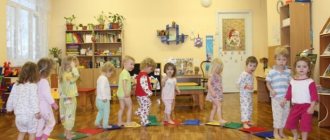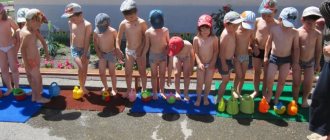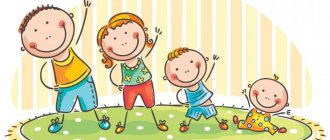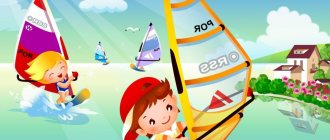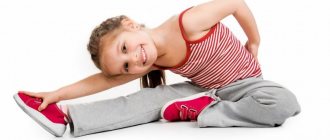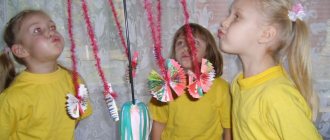“Corrective gymnastics for preschoolers”
“Corrective gymnastics for preschoolers”
Preschool age in the development of a child is the period when the foundation of his health, physical development and culture of movement is laid. However, an analysis of the available data shows that the state of children’s health at present is far from meeting either the needs or potential capabilities of modern society.
Mentally retarded children have a wide variety of developmental disorders, which must be taken into account when designing physical education classes: from the cardiovascular and respiratory systems, as well as physical development and motor skills.
Identifying the capabilities of a mentally retarded child and correcting his developmental defects require special methodological techniques, which should, first of all, be presented in an accessible form. Thus, physical education should be aimed at correcting the physical development of children, deviations in somatic condition and motor skills, as well as at strengthening the health and hardening of the child’s body, promoting proper development, and teaching motor skills.
Corrective exercises are of great importance not only for strengthening the muscles of the body and all-round physical development. They affect the cardiovascular, respiratory and nervous systems. By performing exercises for the arms, legs, and torso, children learn to control their movements, perform them deftly, coordinatedly, with a given amplitude in a certain direction, tempo, and rhythm.
Corrective gymnastics consists of 3 parts: introductory, main and final.
The purpose of the introductory part is to increase the emotional state of children, activate their attention, and prepare the body for the loads of the main part. The content of the introductory part includes drill exercises, various types of walking and running, jumping, exercises for correcting posture and preventing flat feet, and teaching proper breathing. This part ends with children lining up in columns or groups to perform general developmental exercises.
The main part includes general developmental exercises. Exercises are given to develop and strengthen the muscles of the shoulder girdle, abdomen, back and legs, and for the flexibility of the spine.
The exercises are performed from different starting positions - standing, lying, on your back, and on your stomach, sitting. This helps improve the quality of movements, increases the load, and all muscle groups are involved in the work.
To restore the heart rate, gymnastics ends with a final part, which includes physical exercises with a gradual decrease in tempo. (Annex 1)
(Annex 1)
Physical exercises and the content of corrective gymnastics.
Introductory part.
- Form a column one at a time. Walk at an even pace.
- Walking on your toes, on your heels, on the inner and outer arches of your feet, with different hand positions.
— Walking with a bag on the head with simultaneous various movements: in a half-squat, with high knees.
- Normal running. Running with overwhelm. Walking is normal. Walking on a ribbed board, walking on pebbles.
- Walking on a stick sideways with an extension step.
- Running on your toes with high knees.
- Walking on an inclined plane on your toes. Walking is normal.
- Formation from a line into a circle, holding hands. Opening with outstretched arms to the sides.
General development exercises:
1. From the starting position “standing”, lifting on your toes, rolling from your toes to your heels.
2. I. p.: kneeling, hands down. 1 - right hand on the left shoulder. 2 - bend forward, touch the floor with your right elbow; 3-4 - reverse movement. Same with the other hand.
3. "Boat". I. p.: lying on your stomach, arms along the body. 1- bend your legs, grab the ankle joint with your hands. 2-3 use your hands to stretch up, 4- return to i. P.
4. "Wheel". I. p.: lying on your back, arms along the body. 1-2- raising straight legs up, touch the toes of your feet to the floor behind your head. 3-4- return to i. P.
5. “Log”. I.p.: lying on your back, arms up, roll from back to stomach, roll from stomach to back.
6. “Self-extension.” I. p.: lying on your back, arms up. For three counts, stretch upward, stretching the spinal column, with your toes towards you. I. p.: relax.
7. "Fish". I. p.: lying on your stomach, hands above your chin. Maintaining the middle position of the spine, move your arms straight back, bent at the knees, and raise the “fish”.
8. I. p. lying on your back, hands under the lower back. Bend your knees, pull them towards your stomach; Without raising your legs high, straighten them.
9. Jumping in place with your knees raised high.
10. Perform breathing exercises while lying on your back “x-x-ho”, “x-x-ho” - warm your hands - exhale; “f-f-f”, “f-f-f” - cool the water - exhale, “smell a flower” - inhale.
Final part:
— Walking in a column one at a time.
- Running at a fast pace.
- Normal walking.
— Massage of arms and legs - tapping the legs and arms with your fingers.
Get text
Gymnastics after sleep in kindergarten: theory and practice
Sleep plays a vital role in a child's daily routine. How the baby wakes up depends on his mood, state of health and how he will spend the rest of the day. In kindergarten, organizing a proper awakening is more difficult than for parents at home, because it is necessary for 15, 20, or even 30 people to throw off the shackles of Morpheus almost simultaneously, and to do it correctly. Solving such a problem is not easy, but with knowledge of some methodological nuances it is quite possible.
How to properly exercise on a massage mat for children?
Gymnastics on the mat will have a positive effect on your child’s health. To ensure that the exercises do not cause harm, in addition to doing the exercises, you need to follow the basic rules:
- Maintain cleanliness - wash your feet before exercise, and afterward wash the mat under running water and soap.
- The exercises are done barefoot.
- When performing exercises, it is important not to slouch or strain your body.
- The hardness of the rug should be appropriate for its age.
- Start with three minutes of basic exercises and gradually increase the time and intensity of the workout.
- If pain occurs when performing a certain exercise, skip it.
- Be sure to warm up before training, especially at first.
Warm-up
Warm-up should be done before training on an orthopedic mat so that your legs get used to the unusual terrain and there are no unpleasant sensations. Simple exercises will help prepare the muscles, joints and ligaments of the leg for stress. It can be performed after training to relax the muscles. Allow 30-60 seconds for each exercise.
- You need to stand in front of the mat, put one foot on the product, and the other to keep your balance.
- Lightly press your foot onto the surface of the mat and gradually increase the pressure.
- Smooth rolls of the foot from heel to toe and vice versa.
- Place your foot on the inside of the foot and smoothly turn to the outside.
- Repeat the exercises with the other leg.
- Stand on the surface of the massager with both feet and stand.
- If you are warming up after a workout, you can lie down on the surface of the mat and lie there for a few minutes.
Why do you need to exercise on a massage mat?
We have already described in detail the benefits of a massage mat in the article “How to choose a massage mat for children.” It is worth highlighting the main reasons for practicing:
- Walking barefoot on uneven surfaces affects the points of the foot associated with the internal organs.
- The effect on nerve endings stimulates the nervous system and the cerebral cortex, helping with overall development.
- Stimulation of certain reflexogenic zones stimulates the immune system.
- Training the muscles and ligaments of the legs from an early age - preventing foot deformities.
- Exercises on an orthopedic mat help treat clubfoot, flat feet and other pathological changes in the legs.
Exercises after sleep in kindergarten
Kindergarten teachers are amazing people. How many tricks do you need to know in order to take care of and protect, feed and clothe, occupy and develop boys and girls all day long, and even so that they are friendly, cheerful, and healthy! Special sets of gymnastic exercises help each child maintain a healthy mind in a healthy body.
A preschooler's day is divided in half by naps, and waking up becomes a transitional moment on which the child's mood will depend for the rest of the day. That is why gymnastics after sleep is carried out in kindergarten every day. Short in duration, almost imperceptible for the children themselves, it smoothly and carefully helps them fill with vigor and strength.
Gymnastics complex for awakening from sleep for senior groups of preschool educational institutions
The day of children attending kindergarten is divided in half by naps. Waking up is a transitional moment that determines the child's mood for the rest of the day. Rest in the afternoon has a significant impact on the physical and intellectual development of children, helping them regain strength for new achievements. At the same time, it is very important to properly organize the awakening and cheer up the child. Daily exercises after sleep will help with this.
Goals, objectives and techniques
Gymnastics after sleep is a set of exercises that provide a smooth transition from calmness to wakefulness.
The objectives of such classes are:
- increase in muscle tone;
- improved mood;
- prevention of colds;
- strengthening the respiratory system;
- preventing the development of problems with posture, flat feet;
- fostering the habit of stretching the body after waking up.
Not only his mood, but also the emotional atmosphere of the entire group depends on how each child wakes up.
To achieve the goals, every day the teacher selects exercises to solve problems such as:
- toning the nervous system (that is, preventing irritability and anxiety that may arise after waking up);
- improving the functioning of the body’s main systems (cardiovascular, respiratory, as well as stabilizing the body’s protective functions);
- creating a positive atmosphere in the group.
All this is possible with the right combination of gymnastics techniques after sleep.
- The plot of the awakening. This technique is especially important for children of the first and second junior groups. The essence of the technique is that all exercises are carried out within the framework of a common plot. For example, a bear came to visit us and asked for help: her son Mishka could not wake up, and he needed to go to help his mother to pick raspberries for the winter - he needed to show by example how to quickly restore the body after sleep. In addition, it will be more interesting for children to perform certain actions accompanied by rhymes and short sayings.
- Musicality. Quiet, relaxing music, played a little louder than before bed, helps children of any age recover.
Gymnastics after waking up should be done to music
More information about gymnastics after sleep in the preparatory group can be found in our article - We conduct gymnastics after sleep in the preparatory group of the kindergarten.
Games for children using a massage mat
Due to the unusual texture of the mat, the child may refuse to practice. The presence of bright elements, geometric shapes, and multi-colored bumps on the rug can be used for play. The game will attract children's attention and stimulate them to do exercises.
Game “Beetle”
In this game, the child must act out the actions in a rhyme.
The feet and palms will be massaged in a playful way. On a flower, two bugs danced, gopachka
- we march in place,
With our right foot, stomp, stomp
, we stomp with our right foot 2 times,
With our left foot, stomp, stomp, stomp
with our left foot 3 times,
Wings raised up: “Who flies the fastest?”
- you need to jump off and run around the rug.
So we arrived, sat on the flower
- we return to our place, squat down and touch the rug with our palms.
Game “Treasure Hunters”
This is a group game that trains the feet and is aimed at preventing flat feet.
We scatter coins or other game elements on the mat. Children wait for the starting signal and collect “treasures” with their toes. The one who collects them the most wins.
Game “Geese”
The game strengthens the muscles of the torso, arms and feet.
Start – at the beginning of the mat. Children should walk across the mat in a squatting, goose step. The one who reaches the end of the mat the fastest wins.
Game “Bouncing Bunnies”
The game develops the attention of players.
Children should listen to the rhyme and jump onto the mat when they hear the word “jump”, and jump off it when they hear the word “jump”.
To maintain attention, sometimes instead of “jump”, say “jump”. Whoever makes a mistake is out of the game. A jumping bunny was walking. He saw a stump - “jump” on it. Tired of sitting on the stump - “jump” from the stump. He goes further. He sees a beautiful fox - “jump” on the stump. The fox left - the bunny “jumped” from the stump, etc.
Game “Cat and mouse”
The game will help strengthen your leg muscles and train vigilance.
“Mice” run around the territory from the “cat” and hide in houses - they jump onto the rug. The last one not caught by the “cat” wins.
